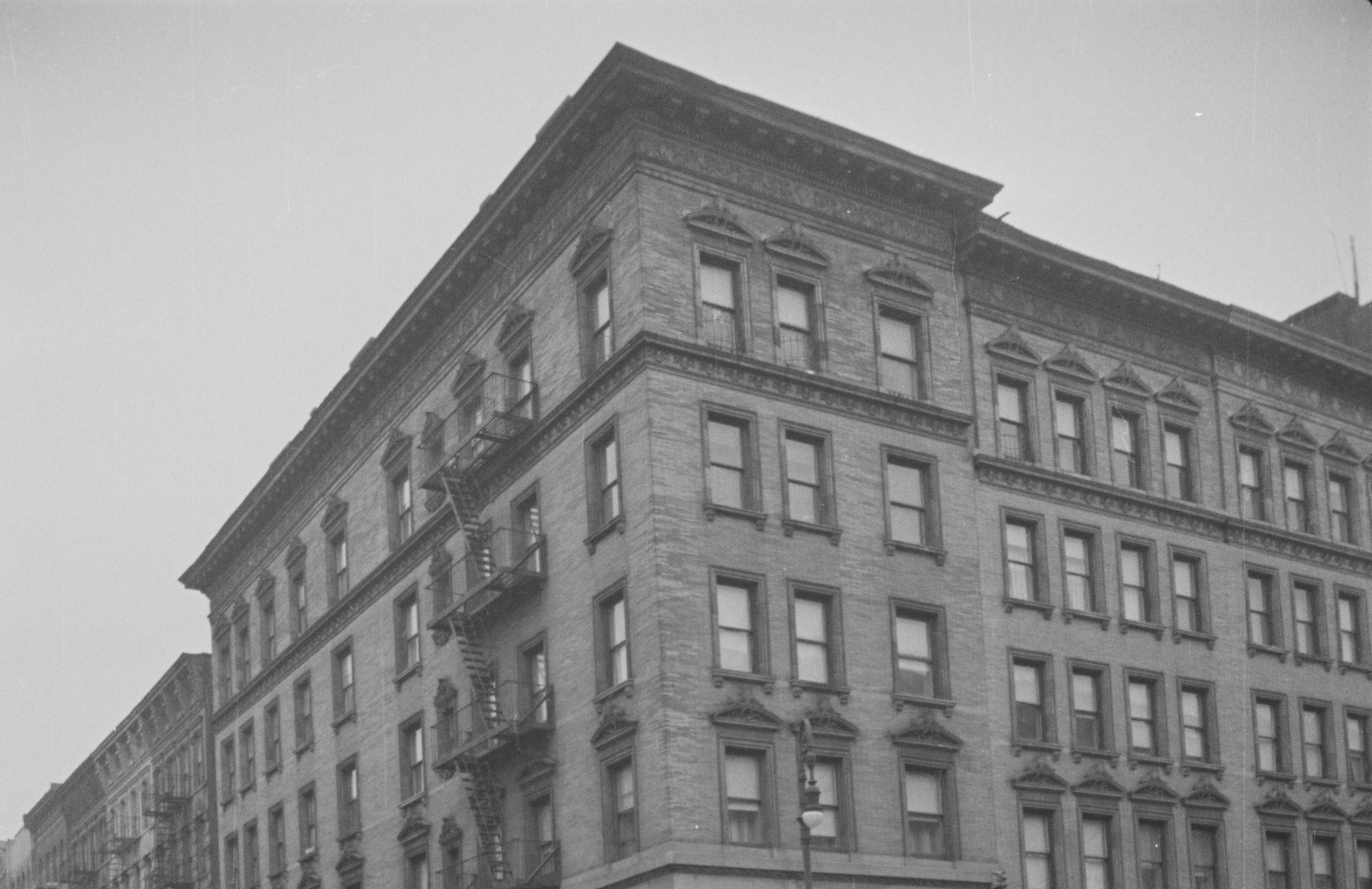
21 Manhattan Avenue
by Tom Miller
In 1895, architect James E. Ware was hired to design three five-story apartment buildings at 21 through 25 Manhattan Avenue. Those plans were scrapped, however, and in 1896, Ware filed plans for four five-story flats—now in conjunction with architect Herbert Spencer Styne-Harde—at 21 to 27 Manhattan Avenue for developer William Walsh.
The corner building, 21 Manhattan Avenue, was substantially more expensive to erect than the others at $32,000 (about $1.2 million in 2025 terms). Because there were stores along the sidewalk (or basement) level on the 101st Street side, each subsequent floor was slightly higher than those of the other three buildings. Faced in yellow Roman brick above the stone-clad two-story base, the building’s tripartite Renaissance Revival design featured terra cotta architrave window frames and elaborate pediments. A handsome intermediate cornice delineated the midsection from the top floor.
An advertisement for a “fine corner apartment” in October 1898 touted, “6 extra large rooms, bath, facing avenue and street; open nickel plated plumbing; hard wood throughout; hot water, steam heat; all improvements; $45.00.” The monthly rate would translate to about $1,710 today.
The tenants represented far-flung professions—artists, theatrical people, civil engineers, and real estate and contracting figures. Among the initial residents were Arthur and Jean Allison Hammerstein, who were married on February 19, 1893. Two years later, they had a daughter, Elaine. Hammerstein was the son of theater impresario and composer Oscar Hammerstein I. When he and Jean moved into 21 Manhattan Avenue, he worked in the “decorating arts.” It was a creative way of saying he did plastering and painting work in his father’s theaters. (He would, however, become a songwriter, dramatist, theater manager, and playwright.)
Jean ousted him from the Manhattan Avenue apartment and, in January 1907, started divorce proceedings.
In 1905, Jean Hammerstein heard a rumor that her husband was being unfaithful. (Hammerstein would later say, “so-called friends spread tales to Mrs. Hammerstein.”) Jean ousted him from the Manhattan Avenue apartment and, in January 1907, started divorce proceedings. Then, a month later, on February 26, The New York Press reported, “When just on the eve of having a decree of divorce confirmed, Arthur Hammerstein announced last night he and his wife had found to live apart forever and never meet again as husband and wife was too much for them to stand.” Arthur told a reporter, “We decided we never ought to have disagreed.” At the time of the article, said Hammerstein, “My wife’s belongings are being moved in from the house where she lived in No. 21 Manhattan avenue.” (The reunion did not last especially long. In 1910, the couple was divorced, and Hammerstein married Grace Weir a few months later.)
Harold R. Faire, a printer and publisher on Wall Street, had his few days of fame starting on January 25, 1907, when he was chosen as a juror in the murder case of Harry Thaw. The sensational crime had riveted readers across the nation, if not the world. Harry Thaw fatally shot architect Stanford White in a jealous rage over his model and actress wife, Evelyn Nesbit. The trial promised to be the most spectacular courtroom drama of the day. The Sun remarked, “Mr. Faire is the only unmarried juror thus far selected.”
Then, on January 30, The Rocky Mountain News titled a front-page article “Two Jurors in the Thaw Case Summarily Excused / Action Veiled in Deepest Mystery.” One of the pair was Harold R. Faire. The article said, “Mr. Faire created a mild sensation when he asserted that he was utterly in ignorance of any reason why he should be asked to step down.”
Among the early residents was artist Gustave Verbeek, who had a colorful background. Born to Dutch missionaries in Nagasaki, Japan in 1867, he left Japan as a young man to study art in Paris. He relocated to America in 1900, and moved into 21 Manhattan Avenue. While here, he did illustrations for magazines like Harper’s and drew weekly comic strips for newspapers. Simultaneously, he pursued serious art and, in 1900 and 1901, exhibited in the annual exhibitions of the Philadelphia Academy of the Fine Arts.
The year that Verbeek moved in, Elizabeth M. Bannister made a stand against animal cruelty. On December 27, 1900, according to her testimony, she saw William H. Moore “driving an emaciated horse attached to a wagon filled with trunks, and…beating the animal with a large whip.” As Elizabeth loudly chastised Moore, a small crowd began congregating. That drew the attention of Patrolman Buettner and Detective McManus. Elizabeth Bannister demanded that they arrest the driver. The horse was taken to a nearby liver stable where a veterinarian “administered stimulants.” Elizabeth Bannister promised to appear in the West Side Court the following morning.
Edward Maurice Montchyk had an impressive resume. He earned his bachelor’s degree from Harvard University in 1900, did graduate work in mathematics and physics at Harvard where he was a Whiting fellow in physics. Living here in 1903, he worked as an electrical engineer with the General Electric Company and as an assistant engineer with Western Electric Company.
Sixteen-year-old Joseph Powell and his family lived here in 1914 when he and his 18-year-old friend, James Martan embarked on a daring adventure. On February 10, “feeling that fame and fortune awaited them in the Wild West,” according to The Evening World, the teens resigned from their jobs, collected their pay, and went to Hoboken, where they bought revolvers, holsters, belts, and cartridges. That night, they started off to the land of cowboys, gold miners, and opportunity. They got as far as 43rd Street and Eleventh Avenue when they were the targets of a gang of snowball-wielding boys. With bravado, Powell drew his weapon, “but the boys continued to pelt them, so Powell and his companion ran, pursued by the boys, who substituted stones for snowballs,” said the article.
That night, they started off to the land of cowboys, gold miners, and opportunity.
At 42nd Street and Twelfth Avenue, the teenagers were rescued by Policeman Monahan, who arrested them for carrying firearms. They were held on $200 bail, their revolvers confiscated, and their dreams of the Golden West dashed.
Singer, voice coach, and actor Gabriel Ravenelle hosted musicals and receptions in his apartment/studio as early as 1915. On July 15 that year, for instance, The Violin World reported, “Arthur Saft, a young Texan violinist of distinguished gifts, was heard at a musicale given on June 15, at the resident of Gabriel Ravenelle in New York.” And on January 27, 1917, Musical America announced, “Gabriel Ravenelle gave the first of his series of teas on Jan. 13 at his studio apartment at 21 Manhattan Avenue. This tea was in honor of his friends, Hallet Gilberte, the composer, and his wife.”
The building continued to house middle-class tenants and never seriously declining. Then, in the early 1950s, work began on the massive Frederick Douglass Houses project that would eventually hold more than 2,000 apartments and 4,000 residents. The project eradicated 22 acres of buildings, including 21 Manhattan Avenue.
Tom Miller is a social historian and blogger at daytoninmanhattan.blogspot.com


